SECTOR ANALYSIS
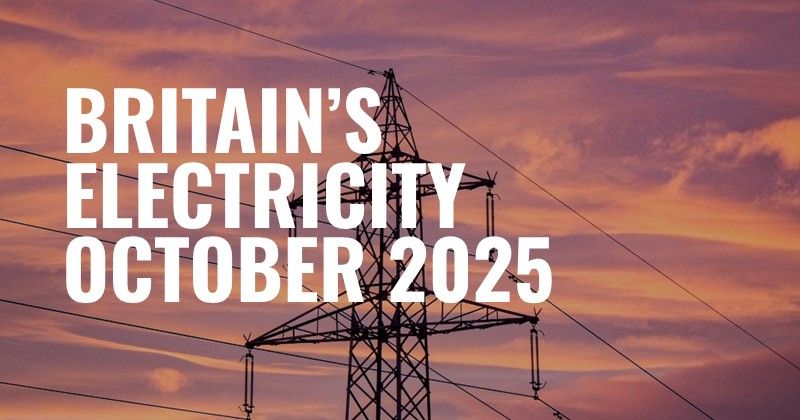
Fuel Type Breakdown Britain's electricity generation in October 2025 was led by wind, which contributed 34% of the energy mix, matching its share from October 2023 but below the 36% recorded in October 2022. This represented a 3 percentage point increase compared to October 2024 and outpaced gas generation by 5 percentage points, reinforcing wind's position as a leading power source. Gas, meanwhile, supplied 29% of electricity in October 2025, marking its second-lowest October contribution in the past five years. This decline highlights ongoing progress in reducing reliance on fossil fuels. Electricity imports accounted for 14% of Britain's generation mix, up 3 percentage points compared to October 2024 and the highest October share in the past five years. This sustained level reflects continued dependence on cross-border electricity flows to balance domestic supply. Nuclear power contributed 10% to the mix, down from 13% in October 2024 and below the 14% seen in 2021, 2022 & 2023. This marks a continued period of reduced nuclear availability. Solar generation delivered 3% of Britain's electricity in October 2025, consistent with October 2023 and October 2021 but 1 percentage point lower than in October 2024 and October 2022. Storage technologies supplied 2% of the mix, up 1 percentage point year-on-year and the highest October contribution in the past five years, signalling ongoing improvements in grid flexibility and battery capacity. Biomass contributed 6% to the mix, 2 percentage points lower than in October 2024. Hydropower remained steady at 2%, largely consistent with October levels across the previous five years. Coal remained absent from the generation mix, continuing Britain's phase-out of coal-fired power. Zero-Carbon Sources & Carbon Intensity Zero-carbon sources, including wind, solar, nuclear, and hydro, delivered 61% of Britain's electricity in October 2025, the highest October share of the previous five years and 10 percentage points higher than in October last year. Carbon intensity for October 2025 remained static compared to October in the previous two years at 138 gCO₂/kWh. This stagnation suggests that more effort is needed to decarbonise Britain's electricity to ensure continued progress towards net zero. Over the longer term, the 12-month rolling average for zero-carbon generation increased by 1% over the previous 12-month period, to 53%. In contrast, the rolling average carbon intensity rose by 8% to 133 gCO₂/kWh compared with the previous 12 months, signalling the importance of accelerating clean energy deployment to sustain downward momentum. Concluding Remarks October 2025 marked a relatively good month for Britain's renewable generation, with wind maintaining its position as the leading power source, though falling short of the 36% achieved in October 2022. Together with growing storage capacity, these sources helped sustain low carbon intensity levels. However, the decline in nuclear generation and continued reliance on imports highlight the need for further investment in domestic clean energy infrastructure and flexible technologies. While progress in storage and renewable deployment is evident, maintaining long-term momentum will be essential to achieving sustained reductions in carbon intensity towards net zero and strengthening Britain's energy resilience. Britain's Electricity Summary Charts

edenseven are following trends in the renewable energy sector closely, as decarbonising the energy sector is vital for ensuring a sustainable future and achieving Net Zero. Considering the recent DESNZ quarterly update of the renewable energy planning database, we have produced a consolidated summary of projects in the United Kingdom that have received planning permission. We will continue to release updates each quarter. Key Insights: Solar photovoltaic (PV) is scaling rapidly, driven by falling costs and strong investor appetite. In the last 12-months (ending Q2), 662 projects were approved, the third-highest 12-month period ending Q2 in 16 years, representing a record 4,831 MW of new capacity, with an average project size of 7 MW. Offshore wind, meanwhile, continues to demonstrate a mature, large-scale market with fewer but much larger developments. Six projects were approved in the last 12-months (ending Q2), also the joint third-highest year on record, delivering a record 6,803 MW of capacity and an average project size of 1,134 MW. In contrast, onshore wind growth remains constrained by planning and policy barriers, with 43 projects approved in the last 12 months (ending Q2), ranking 12th out of 16 years, and a relatively modest 915 MW of capacity, averaging 21 MW per project. Overall, total capacity for approved wind and solar projects in the last 12-months (ending Q2) reached a record 12,549 MW. While project numbers remain steady, the average scale of developments is increasing sharply, signaling that the UK’s renewable expansion is shifting from volume to scale, led by large solar and offshore wind projects.
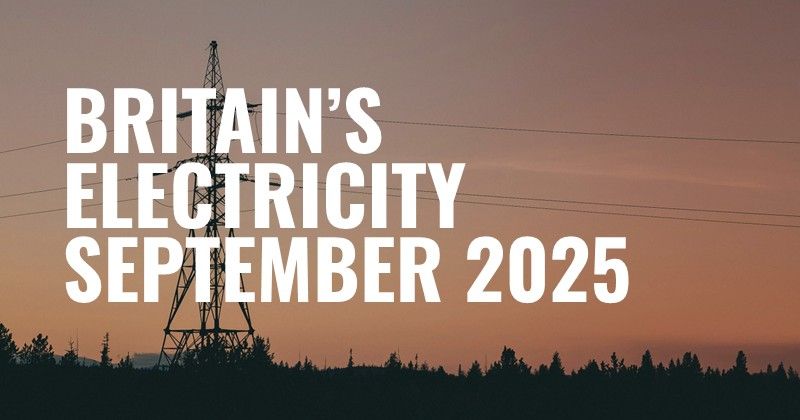
Fuel Type Breakdown Britain’s electricity generation in September 2025 was led by wind, which contributed 35% of the energy mix, its highest September share in the past five years. This represented a 9 percentage point increase compared to September 2024 and outpaced gas generation by 13 percentage points, reinforcing wind’s continued dominance as Britain’s leading power source. Gas, meanwhile, supplied 22% of electricity in September 2025, marking its lowest September contribution in the past five years and half of the share recorded in September 2022. This decline highlights ongoing progress in reducing reliance on fossil fuels. Electricity imports accounted for 15% of Britain’s generation mix, consistent with September 2024 but remaining substantially higher than in 2021 (10%), 2022 (2%), and 2023 (11%). This sustained level reflects continued dependence on cross-border electricity flows to balance domestic supply. Nuclear power contributed 10% to the mix, down from 16% in September 2024 and below the levels seen in 2021 (16%), 2022 (15%), and 2023 (17%). This marks a continued period of reduced nuclear availability. Solar generation delivered 7% of Britain’s electricity in September 2025, its highest September share in the past five years and 1 percentage point higher than in September 2024. This record contribution highlights solar’s growing role in supporting Britain’s late-summer energy demand. Storage technologies supplied 2% of the mix, up 1 percentage point year-on-year and the highest September contribution in the last five years, signalling ongoing improvements in grid flexibility and battery capacity. Biomass contributed 7% to the mix, 1 percentage point lower than in September 2024 but still representing its second-highest September share in the past five years. Hydropower remained steady at 2%, consistent with levels in 2023 and 2024, and 1 percentage point above those recorded in 2021 and 2022. Coal remained absent from the generation mix, continuing Britain’s phase-out of coal-fired power. Zero-Carbon Sources & Carbon Intensity Zero-carbon sources, including wind, solar, nuclear, and hydro, delivered 67% of Britain’s electricity in September 2025, the highest share of any month on record and nearly 30 percentage points higher than in September 2021. This milestone reflects the steady structural shift toward a cleaner, more sustainable energy system. Carbon intensity for September 2025 fell to 112 gCO₂/kWh, the lowest September figure in the past five years and 45% below the level recorded in September 2021, underscoring substantial progress in reducing emissions from electricity generation. Over the longer term, the 12-month rolling average for zero-carbon generation remained at 52%, consistent with the previous period and indicating a short-term plateau in renewable expansion. In contrast, the rolling average carbon intensity rose by 8% to 133 gCO₂/kWh compared with the previous 12 months, signalling the importance of accelerating clean energy deployment to sustain downward momentum. Concluding Remarks September 2025 marked a strong month for Britain’s renewable generation, led by record wind output and growing solar capacity. Together, these sources helped deliver the highest September share of zero-carbon electricity in five years, driving carbon intensity to new lows. However, the decline in nuclear generation and continued reliance on imports highlight the need for further investment in domestic clean energy infrastructure and flexible technologies. While progress in storage and renewable deployment is evident, maintaining long-term momentum will be essential to achieving sustained reductions in carbon intensity and strengthening Britain’s energy resilience. Britain's Electricity Summary Charts
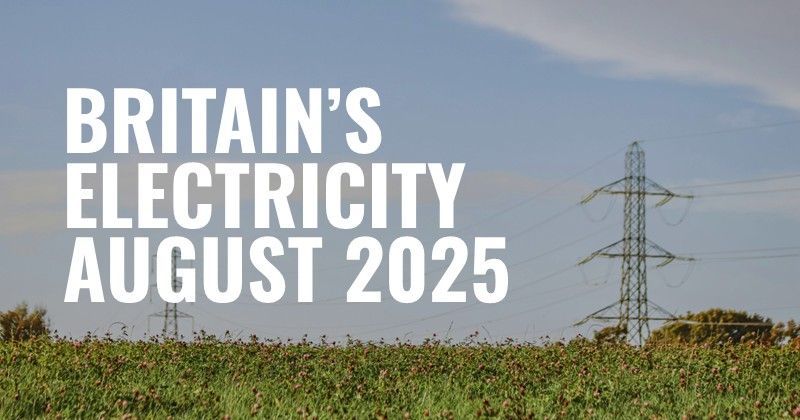
Fuel Type Breakdown Britain’s electricity generation in August 2025 was led by wind, which supplied 26% of the mix. While this marked a strong showing, it was notably down from 32% in August 2024. Despite the decline, it represented the second-highest August wind share in the past five years, underscoring the technology’s continued importance. Gas accounted for 23%, a sharp decline from August 2021 (36%), 2022 (48%), and 2023 (35%), though still above its 17% share in August 2024. These fluctuations reflect both progress in reducing dependence on fossil fuels and the current limitations of grid storage, underscoring gas’s continued role as a flexible backup source. Electricity imports accounted for 19%, their highest August share in the past five years and 5 percentage points higher than in August 2024. This growing dependence raises concerns about energy security and highlights the importance of strengthening domestic generation capacity and storage. Nuclear output fell to 11%, its lowest August contribution in the past five years, down 7 percentage points from August 2024 and 4 points below its levels in August 2021–2023. Biomass provided 8%, up from 7% in August 2024 and higher than its contributions in August 2021–2023, confirming its role as a reliable renewable source. Solar reached 10%, its highest August share in the past five years and 2 percentage points above August 2024, reflecting favourable summer conditions and incremental growth in installed capacity. Hydropower contributed 1%, broadly consistent with previous August levels. Storage matched its joint-highest August contribution at 2%, equalling 2024 and demonstrating the growing role of flexibility solutions in balancing the grid. Zero-Carbon Sources & Carbon Intensity Zero-carbon sources; wind, solar, nuclear, and hydro, accounted for 62% of Britain’s electricity in August 2025, the highest share for any August in the past five years. This milestone reflects steady structural progress in decarbonising the grid. Despite the strong zero-carbon contribution, carbon intensity rose to 123 gCO₂/kWh. While this was the second-lowest August value in the past five years, it was 48% higher than the record-low 83 gCO₂/kWh achieved in August 2024. The increase was driven by reduced nuclear and wind contributions alongside higher gas and import reliance. Looking at broader trends, the 12-month rolling average for zero-carbon generation declined slightly to 51%, down 1 percentage point from the previous 12-month period. This plateau indicates a temporary slowdown in renewable integration. Meanwhile, the rolling average carbon intensity rose by 6% to 134 gCO₂/kWh, emphasising the need to accelerate clean energy deployment. Concluding Remarks August 2025 saw wind retain its lead as the largest generation source, though its share dipped below 2024’s record levels. Gas rebounded from its unusually low contribution last year, while imports reached a five-year August high, highlighting ongoing vulnerabilities in energy security. Nuclear’s decline to its weakest August performance in five years further compounded these challenges. Nevertheless, the record-high share of zero-carbon sources for August, alongside growth in solar, biomass, and storage, demonstrates resilience and long-term progress in decarbonisation. Sustaining momentum will require renewed investment in renewables, reinforcement of grid infrastructure, and policies that strengthen domestic supply to ensure both cleaner and more secure electricity in the years ahead. Britain's Electricity Summary Charts
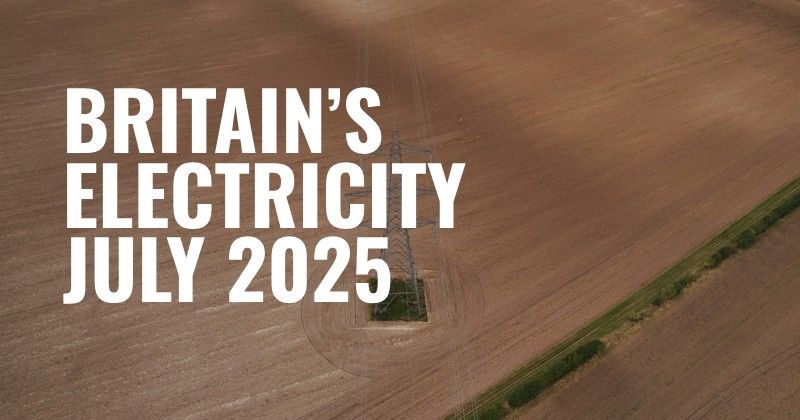
Fuel Type Breakdown Britain’s electricity generation in July 2025 was led by gas, which accounted for 25% of the energy mix. While this marks a continuation of gas as a primary source, it represents its second-lowest July share in the past five years, signalling gradual progress in reducing reliance on fossil fuels. Electricity imports contributed 20% of the mix, their highest July share in the past five years. This increase, which placed imports ahead of wind generation, raises concerns about energy security and highlights the importance of bolstering domestic supply. Wind contributed 19% to the electricity mix, a 2-percentage point decline from July 2024 and 10 points below its July 2023 share, underscoring seasonal variability and the need for continued investment in grid flexibility. Nuclear provided 15%, down 1 percentage point year-on-year but consistent with its average July performance over the past five years, maintaining its role as a stable baseload low-carbon source. Solar generation rose by 2 percentage points year-on-year to reach 11%, its highest July contribution in the last five years. Biomass and storage also saw modest increases of 1 percentage point each, reaching 8% and 2%, respectively, both their highest July shares in the past five years. Hydropower remained stable at 1%, in line with its contribution in July 2024. Coal remained absent from the generation mix, continuing its phase-out completed at the end of 2024. Zero-Carbon Sources & Carbon Intensity Zero-carbon sources, including wind, solar, nuclear, and hydro, provided 48% of Britain’s electricity in July 2025. While up from 34% in July 2021, this figure was slightly below July 2023’s 52% and only a marginal improvement over the 47% recorded in July 2024, reflecting limited year-on-year progress. Carbon intensity rose to 129 gCO₂/kWh, a 13% increase compared to July 2024, driven by lower wind output and increased gas and import use. Looking at broader trends, the 12-month rolling average for zero-carbon generation held steady at 51%, unchanged from the previous 12-month period. This plateau suggests that the pace of renewable integration has temporarily slowed. The rolling average carbon intensity rose slightly to 131 gCO₂/kWh, up from 129 gCO₂/kWh in June, reinforcing the need for continued decarbonisation efforts. Despite these short-term challenges, the rolling carbon intensity remains the lowest seen in the past five years, reflecting sustained long-term progress. Concluding Remarks July 2025 saw gas return as the leading fuel source, while wind’s contribution fell below recent seasonal norms. Rising imports and a modest increase in carbon intensity signal emerging challenges around energy security and clean generation. Nevertheless, gains in solar, biomass, and storage demonstrate resilience within the zero-carbon segment. The continued absence of coal and stable nuclear output reinforces the structural transition underway. To maintain momentum, renewed focus is needed on accelerating renewable deployment, strengthening grid flexibility, and supporting domestic capacity. These are critical steps to ensure consistent progress toward a low-carbon energy future. Britain's Electricity Summary Charts
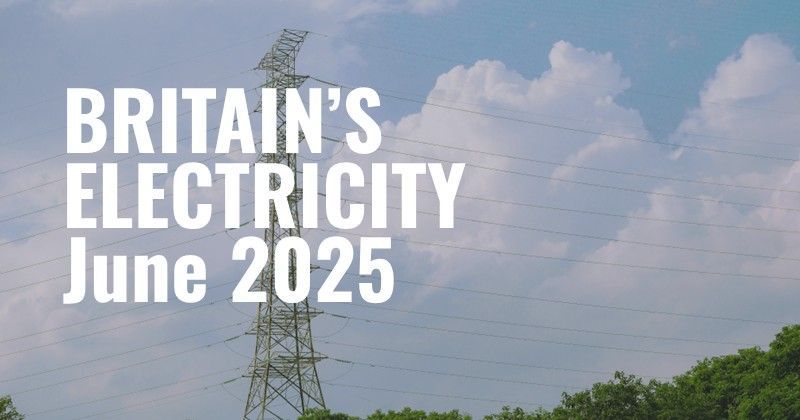
Fuel Type Breakdown Britain’s electricity generation in June 2025 was led by wind, which contributed 31% of the energy mix, its highest June share in the past five years. This marked a 6-percentage point increase compared to June 2024 and was double the share recorded in June 2021, reinforcing wind’s growing dominance in the summer energy mix. Gas accounted for just 17% of electricity generation, its lowest June share in the past five years. This represented a 2-percentage point decline from June 2024, and a 50% drop compared to June 2021, highlighting continued progress in reducing reliance on fossil fuels. Solar generation rose by 2 percentage points year-on-year to reach 12%, its highest June contribution in the last five years. Biomass and storage also saw modest increases of 1 percentage point each compared to June 2024, contributing 8% and 2%, respectively, indicating incremental gains in both dispatchable renewable supply and energy flexibility. Nuclear contributed 15% to the mix, down 2 percentage points from June 2024 but consistent with its average performance over the past five years, maintaining its role as a stable, low-carbon baseload source. Hydropower remained steady at 1%, while coal remained absent from the generation mix for the second consecutive June, following its full phase-out. Electricity imports fell to 15%, a 4-percentage point decline from June 2024. While still notable, this decrease points to an improving balance between domestic generation and external supply. Zero-Carbon Sources & Carbon Intensity Zero-carbon sources, including wind, solar, nuclear, and hydro, delivered 61% of Britain’s electricity in June 2025, the highest June share in recent years and an 11-percentage point increase from June 2024. This increase in clean generation contributed to a further decline in carbon intensity, which fell to 98 gCO₂/kWh, 1% lower than the same month last year. Looking at broader trends, the 12-month rolling average for zero-carbon generation held steady at 51%, consistent with the previous 12-month period. Meanwhile, the rolling average carbon intensity dropped to 129 gCO₂/kWh, its lowest level in the past five years and 4% below the level recorded a year earlier, signaling sustained, long-term progress in grid decarbonisation despite short-term variability. Concluding Remarks June 2025 marked a significant step forward in Britain’s clean energy transition, with wind reaching its highest June share in five years and solar achieving a new seasonal peak. These gains, alongside growth in storage and biomass, pushed zero-carbon sources to a five-year high for the month and drove carbon intensity to one of its lowest recorded levels. The continued decline in gas and the absence of coal underscore the pace of decarbonisation. However, the slight drop in nuclear output, modest hydro performance, and the ongoing reliance on imports highlight areas where further progress is needed to strengthen domestic energy resilience. Sustained investment in renewable generation, grid flexibility, and energy storage will be key to building on this momentum and ensuring continued reductions in carbon intensity across all seasons. Britain's Electricity Summary Charts
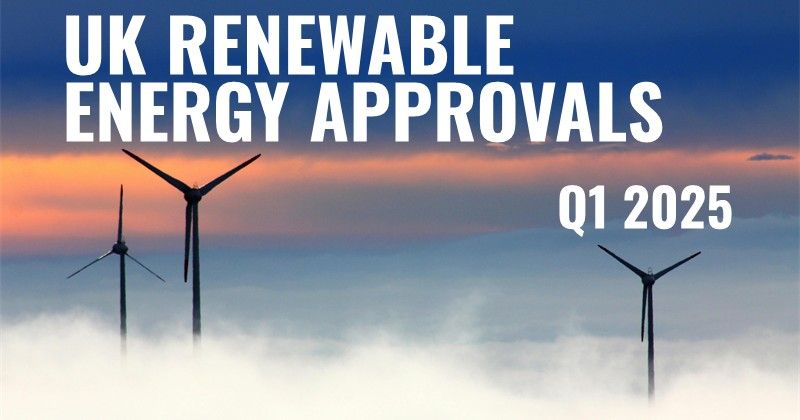
edenseven are following trends in the renewable energy sector closely, as decarbonising the energy sector is vital for ensuring a sustainable future and achieving Net Zero. Considering the recent DESNZ quarterly update of the renewable energy planning database, we have produced a consolidated summary of projects in the United Kingdom that have received planning permission. We will continue to release updates each quarter. INSIGHT Over the past 12 months, the UK approved 690 solar PV projects, 19% lower than the previous 12-month period. Despite the decline in project numbers, the total approved energy capacity rose by 16%, reaching the highest level for solar PV granted planning permission in any 12-month period over the last 16 years. Onshore wind approvals increased, with 46 projects granted permission, up by 28% year-on-year. However, the total energy capacity from these projects fell by 33%, and the average capacity per project dropped by 47%, reflecting a shift toward smaller-scale onshore developments in the last 12-months. Offshore wind saw a 67% increase in project approvals, with five projects granted permission. Yet, total energy capacity fell by 61%, and the average capacity per project declined by 77%, marking a significant reduction in project scale. In total, the combined approved energy capacity from solar PV, onshore wind, and offshore wind over the last 12 months reached 6,745 MW, ranking fourth-highest across the past 16 years.
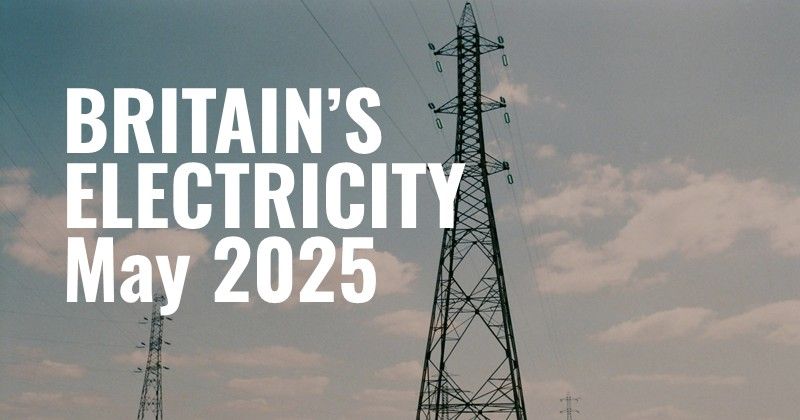
Fuel Type Breakdown Britain’s electricity generation in May 2025 was led by wind, which contributed 27% of the energy mix, its highest May share in the past five years. This marked an 8 percentage point increase compared to May 2024, reinforcing wind’s role as the backbone of Britain’s clean energy supply. Gas, on the other hand, accounted for just 20% of the electricity mix, down 5 percentage points from May 2024 and its lowest May contribution in five years. Notably, gas generation in May 2025 was half of that in May 2021, signalling measurable progress in reducing reliance on fossil fuels. Nuclear power contributed 15% to the mix, a figure that has remained relatively stable in recent years. While slightly below the 17% share seen in May 2022 and 2024, it matches contributions in May 2021 and 2023, reflecting a continued but stagnant role in the generation mix. Solar generation rose significantly, climbing 4 percentage points year-on-year to reach 12%, its highest May contribution in the last five years. This growth underscores solar’s expanding role in supporting seasonal energy demand. Biomass remained consistent, supplying 7% of Britain's electricity in May 2025, in line with its contribution in May 2024. Hydropower also maintained a consistent presence at 1%, though this was below the 2% observed in May 2022. Electricity imports fell slightly to 17%, down from 19% in May 2024, but still substantially above the 2% recorded in May 2022. Meanwhile, storage technologies contributed 2%, marking their highest May share in the last five years and reflecting incremental progress in energy flexibility. Coal remained absent from the generation mix in May 2025, following its complete phase-out from the grid. Zero-Carbon Sources & Carbon Intensity Zero-carbon sources, including wind, solar, nuclear, and hydro, delivered 57% of Britain’s electricity in May 2025, the highest May share in recent years and a 12 percentage point increase from May 2024. This boost in clean generation contributed to a notable reduction in carbon intensity, which fell to 106 gCO₂/kWh, 15% lower than the previous year. In longer terms, the 12-month rolling average for zero-carbon generation reached 50%, up 1% from April’s update but still 1% below the level seen one year earlier. In contrast, the rolling average carbon intensity sits at 129 gCO₂/kWh, the lowest level of the past five years, indicating gradual improvement despite short-term fluctuations. Concluding Remarks May 2025 saw a strong rebound in wind and solar generation, helping to push zero-carbon sources to their highest May share in recent years and driving carbon intensity to new lows. The continued decline in gas and the absence of coal signal real progress, although the stability of nuclear, combined with limited hydro output and a marginal decline in the 12-month rolling average energy generation from zero-carbon sources, highlight the importance of accelerating renewable deployment to maintain momentum. With imports still high and storage only beginning to scale, the data points to both achievements and remaining vulnerabilities. To ensure long-term resilience and carbon reduction, sustained investment in domestic renewables and flexible technologies will be essential. Britain's Electricity Summary Charts
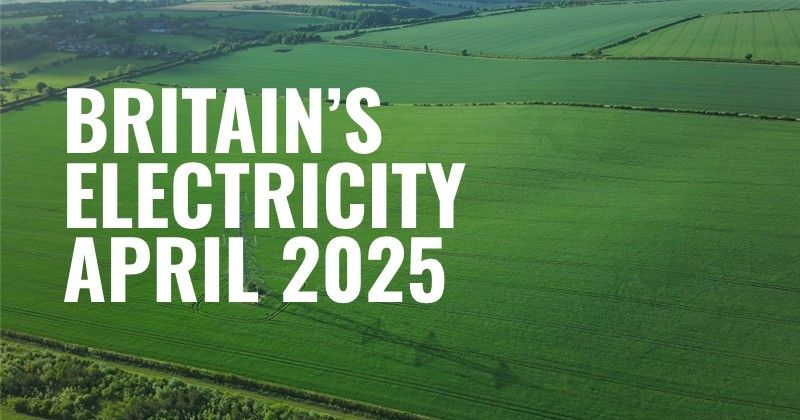
Fuel Type Breakdown Britain’s electricity generation in April 2025 saw a notable shift, with gas reclaiming its position as the leading source of electricity generation. Contributing 26% of the energy mix, gas usage rose by nearly 10 percentage points compared to April 2024. Despite this, gas consumption remained below levels seen in April 2021, 2022, and 2023. The rise in gas was largely a response to a substantial drop in wind energy generation, which fell by more than 10 percentage points year-on-year to 22%. This was wind’s second-lowest April contribution in the last five years. The shortfall in wind output played a critical role in driving up reliance on fossil fuels, undermining progress toward a cleaner energy mix. Likely as a result of favourable weather conditions, solar generation rose sharply, from 6% in April 2024 to 11% in April 2025. This marks its highest April contribution in five years and highlights solar’s growing potential in Britain’s energy transition. Conversely, nuclear power continued to decline, contributing just 14% to the electricity mix, down from 16% the previous year and its lowest April share in half a decade. The consistent drop in nuclear output, coupled with weak wind performance, placed additional pressure on other sources to fill the gap. Biomass remained stable at 7%, matching its highest April contribution in the last five years, while hydropower fell slightly to 1%. Together, these sources provided limited compensation for the downturn in wind and nuclear output. Coal contributed 0%, following its complete phase-out in September 2024. For context, coal had still accounted for 1% of electricity generation in April 2024. Electricity imports increased by 3 percentage points to 18%, the highest April share in five years, suggesting growing reliance on cross-border supply to maintain grid stability. Similarly, storage technologies contributed 2% to the mix, their highest April level to date, signaling incremental progress in energy flexibility and resilience. Zero-Carbon Sources & Carbon Intensity Zero-carbon sources, comprising wind, solar, nuclear, hydro accounted for 46% of electricity generation in April 2025. This represented a 13% decline from April 2024, and was accompanied by a sharp rise in carbon intensity to 133 gCO₂/kWh, a 45% year-on-year increase. Over a longer timeframe, the 12-month rolling average for zero-carbon generation stood at 49%, down 2% from the previous year. Meanwhile, the 12-month rolling average carbon intensity stood at 131 gCO₂/kWh, only 8% lower than the year before and a sharp contrast to the 22% year-on-year reduction recorded ju st six months earlier in October 2024. This underscores a concerning stagnation in Britain’s clean energy momentum. Concluding Remarks April's mixed performance highlights a concerning slowdown in Britain's progress towards a decarbonised energy grid. The decline in the share of renewables over the last 12-months, coupled with only an 8% year-on-year reduction in carbon intensity, highlights a loss of momentum in decarbonising the grid. While the increased supply from solar and storage is a positive development, the decline in wind, nuclear and hyrdo is concerning. Although wind's decline may reflect temporary weather conditions, the broader trend signals an urgent need to ramp up investment into renewables. To restore progress toward a resilient, net zero power system and reduce dependence on imports, Britain must accelerate the deployment of renewables and strengthen its commitment to long-term energy security. Britain's Electricity Summary Charts



